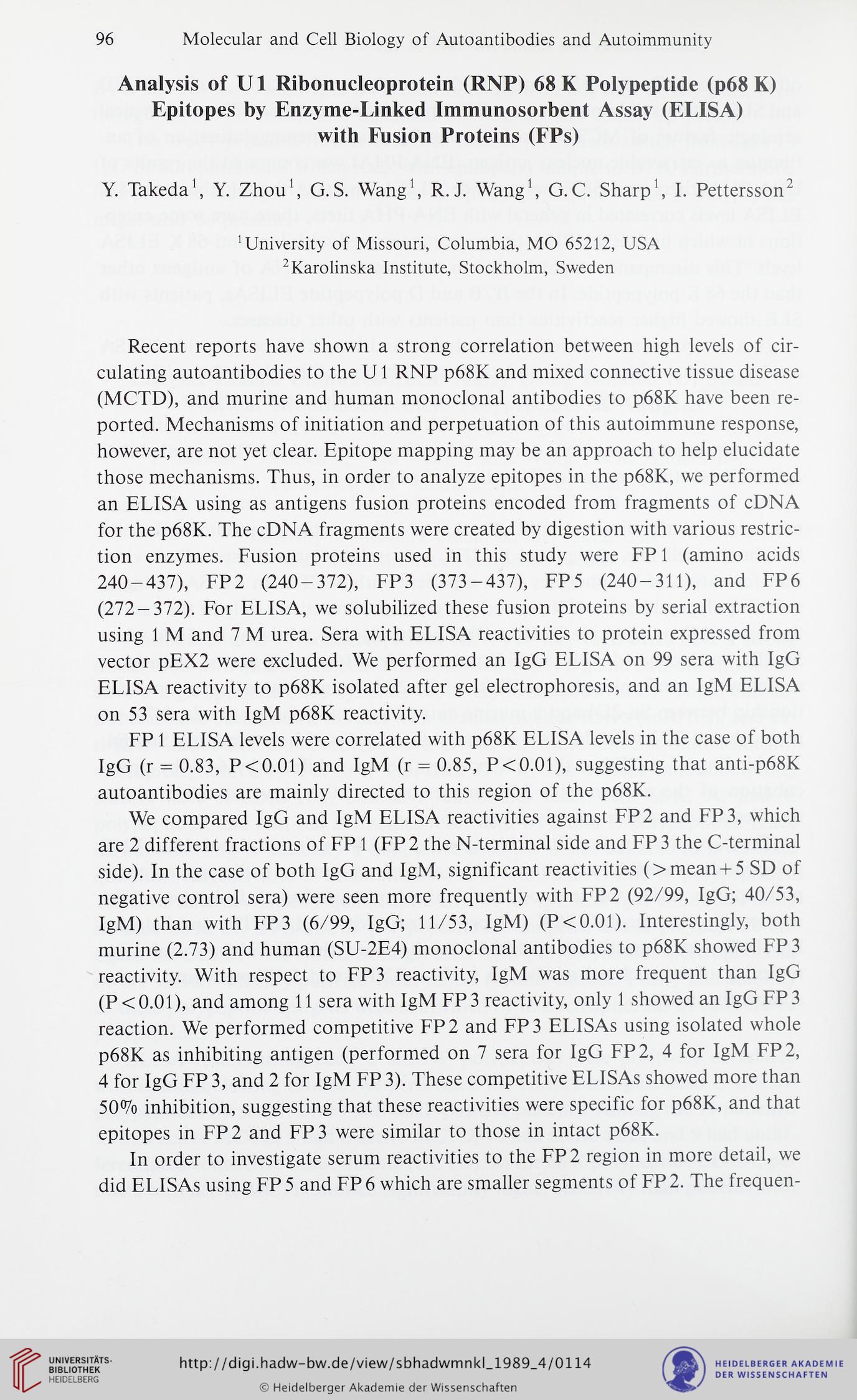96
Molecular and Cell Biology of Autoantibodies and Autoimmunity
Analysis of U1 Ribonucleoprotein (RNP) 68 K Polypeptide (p68 K)
Epitopes by Enzyme-Linked Immunosorbent Assay (ELISA)
with Fusion Proteins (FPs)
Y. Takeda1, Y. Zhou1, G. S. Wang1, R. J. Wang1, G. C. Sharp1, I. Pettersson2
‘University of Missouri, Columbia, MO 65212, USA
2Karolinska Institute, Stockholm, Sweden
Recent reports have shown a strong correlation between high levels of cir-
culating autoantibodies to the U1 RNP p68K and mixed connective tissue disease
(MCTD), and murine and human monoclonal antibodies to p68K have been re-
ported. Mechanisms of initiation and perpetuation of this autoimmune response,
however, are not yet clear. Epitope mapping may be an approach to help elucidate
those mechanisms. Thus, in order to analyze epitopes in the p68K, we performed
an ELISA using as antigens fusion proteins encoded from fragments of cDNA
for the p68K. The cDNA fragments were created by digestion with various restric-
tion enzymes. Fusion proteins used in this study were FP1 (amino acids
240-437), FP2 (240-372), FP3 (373-437), FP5 (240-311), and FP6
(272-372). For ELISA, we solubilized these fusion proteins by serial extraction
using 1 M and 7 M urea. Sera with ELISA reactivities to protein expressed from
vector pEX2 were excluded. We performed an IgG ELISA on 99 sera with IgG
ELISA reactivity to p68K isolated after gel electrophoresis, and an IgM ELISA
on 53 sera with IgM p68K reactivity.
FP 1 ELISA levels were correlated with p68K ELISA levels in the case of both
IgG (r = 0.83, P<0.01) and IgM (r = 0.85, P<0.01), suggesting that anti-p68K
autoantibodies are mainly directed to this region of the p68K.
We compared IgG and IgM ELISA reactivities against FP2 and FP3, which
are 2 different fractions of FP 1 (FP2 the N-terminal side and FP3 the C-terminal
side). In the case of both IgG and IgM, significant reactivities (>mean + 5 SD of
negative control sera) were seen more frequently with FP2 (92/99, IgG; 40/53,
IgM) than with FP3 (6/99, IgG; 11/53, IgM) (P<0.01). Interestingly, both
murine (2.73) and human (SU-2E4) monoclonal antibodies to p68K showed FP3
reactivity. With respect to FP3 reactivity, IgM was more frequent than IgG
(P<0.01), and among 11 sera with IgM FP3 reactivity, only 1 showed an IgG FP3
reaction. We performed competitive FP2 and FP3 ELISAs using isolated whole
p68K as inhibiting antigen (performed on 7 sera for IgG FP2, 4 for IgM FP2,
4 for IgG FP 3, and 2 for IgM FP 3). These competitive ELISAs showed more than
50% inhibition, suggesting that these reactivities were specific for p68K, and that
epitopes in FP2 and FP3 were similar to those in intact p68K.
In order to investigate serum reactivities to the FP2 region in more detail, we
did ELISAs using FP 5 and FP 6 which are smaller segments of FP 2. The frequen-
Molecular and Cell Biology of Autoantibodies and Autoimmunity
Analysis of U1 Ribonucleoprotein (RNP) 68 K Polypeptide (p68 K)
Epitopes by Enzyme-Linked Immunosorbent Assay (ELISA)
with Fusion Proteins (FPs)
Y. Takeda1, Y. Zhou1, G. S. Wang1, R. J. Wang1, G. C. Sharp1, I. Pettersson2
‘University of Missouri, Columbia, MO 65212, USA
2Karolinska Institute, Stockholm, Sweden
Recent reports have shown a strong correlation between high levels of cir-
culating autoantibodies to the U1 RNP p68K and mixed connective tissue disease
(MCTD), and murine and human monoclonal antibodies to p68K have been re-
ported. Mechanisms of initiation and perpetuation of this autoimmune response,
however, are not yet clear. Epitope mapping may be an approach to help elucidate
those mechanisms. Thus, in order to analyze epitopes in the p68K, we performed
an ELISA using as antigens fusion proteins encoded from fragments of cDNA
for the p68K. The cDNA fragments were created by digestion with various restric-
tion enzymes. Fusion proteins used in this study were FP1 (amino acids
240-437), FP2 (240-372), FP3 (373-437), FP5 (240-311), and FP6
(272-372). For ELISA, we solubilized these fusion proteins by serial extraction
using 1 M and 7 M urea. Sera with ELISA reactivities to protein expressed from
vector pEX2 were excluded. We performed an IgG ELISA on 99 sera with IgG
ELISA reactivity to p68K isolated after gel electrophoresis, and an IgM ELISA
on 53 sera with IgM p68K reactivity.
FP 1 ELISA levels were correlated with p68K ELISA levels in the case of both
IgG (r = 0.83, P<0.01) and IgM (r = 0.85, P<0.01), suggesting that anti-p68K
autoantibodies are mainly directed to this region of the p68K.
We compared IgG and IgM ELISA reactivities against FP2 and FP3, which
are 2 different fractions of FP 1 (FP2 the N-terminal side and FP3 the C-terminal
side). In the case of both IgG and IgM, significant reactivities (>mean + 5 SD of
negative control sera) were seen more frequently with FP2 (92/99, IgG; 40/53,
IgM) than with FP3 (6/99, IgG; 11/53, IgM) (P<0.01). Interestingly, both
murine (2.73) and human (SU-2E4) monoclonal antibodies to p68K showed FP3
reactivity. With respect to FP3 reactivity, IgM was more frequent than IgG
(P<0.01), and among 11 sera with IgM FP3 reactivity, only 1 showed an IgG FP3
reaction. We performed competitive FP2 and FP3 ELISAs using isolated whole
p68K as inhibiting antigen (performed on 7 sera for IgG FP2, 4 for IgM FP2,
4 for IgG FP 3, and 2 for IgM FP 3). These competitive ELISAs showed more than
50% inhibition, suggesting that these reactivities were specific for p68K, and that
epitopes in FP2 and FP3 were similar to those in intact p68K.
In order to investigate serum reactivities to the FP2 region in more detail, we
did ELISAs using FP 5 and FP 6 which are smaller segments of FP 2. The frequen-




